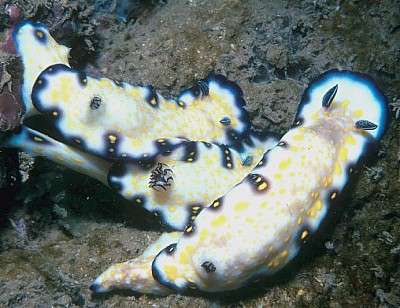
Risbecia imperialis
(Pease, 1860)
Order: NUDIBRANCHIA
Suborder: DORIDINA
Superfamily: EUDORIDOIDEA
Family: Chromodorididae
DISTRIBUTION
Hawaii, and possibly Marshall Ids (see message below.
PHOTO
Honolulu, Hawaii. Photo: Scott Johnson
Risbecia imperialis, first described from Hawaii, and R. godeffroyana, originally described from Tahiti, and more recently reported (Rudman, 1987), from tropical Eastern Australia and Papua New Guinea), are very similarly coloured and probably closely related species. Unfortunately specimens from Hawaii are still unavailable for anatomical comparision.
Risbecia imperialis is creamy white with a dark blue mantle border which has a series of 'fingers' which extend in towards the center of the mantle. The fingers have a row of bright yellow spots. Inside the blue border there is a band of large yellow spots. The rest of the mantle is patterned with slightly smaller yellow spots which are somewhat paler in colour than the outer band. The foot is bordered with dark blue and has a scattering of large yellow spots. The rhinophore club is dark blue with some white spots along the edge of the lamellae and a white line up the anterior and posterior edges of the club. The gills are white with blue edging.
The preferred food of R. imperialis in Hawaii is Dysidea fragilis. It is known only from Hawaii and from a single record from the Marshall Ids. [See Scott Johnson's message below].
The East African R. pulchella is clearly closely related, the main external difference being the purple border to the foot in that species, and the smudged pale purple reticulate pattern on the dorsum.
Reference:
• Rudman, W.B. (1987). The Chromodorididae (Opisthobranchia: Mollusca) of the Indo-West Pacific: Chromodoris epicuria, C. aureopurpurea, C. annulata, C. coi and Risbecia tryoni colour groups. Zoological Journal of the Linnean Society, 90: 305-407.
Note added 9 Jan 2001: R. imperialis and R. godeffroyana have previously been considered on the Forum to be colour forms of one species with all records being placed on the R. imperialis page. They are now separated as two species. See accompanying message.
Authorship detailsRudman, W.B., 2001 (January 8) Risbecia imperialis (Pease, 1860). [In] Sea Slug Forum. Australian Museum, Sydney. Available from http://www.seaslugforum.net/find/risbimpe
Related messages
Re: Risbecia imperialis from Hawaii
January 9, 2007
From: Cory Pittman
Concerning message #19107:
Dear Bill,
Risbecia imperialis was virtually "nonexistent" around Maui [Hawaii, USA, Pacific] throughout the late 1980s and 1990s -- I saw my first specimen in 2000. However, since then they've increased steadily becoming one of the three or four most commonly seen chromodorids during the last couple of years -- often with as many as half a dozen seen during a single dive. So, there appears to be a long term population swing involved. Whether it's random or cyclic...?
More later,
Cory
cory@cet.com
Dear Cory,
Thanks for the observation. I look forward to 'more later' - any chance of some photos of it on its food sponge?
Best wishes,
Bill Rudman
Risbecia imperialis from Hawaii
January 5, 2007
From: Aidan Hampson
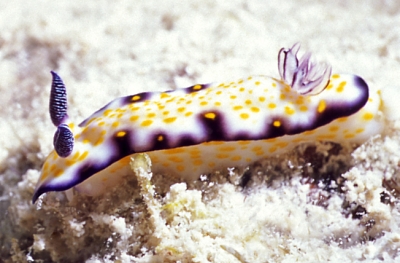
Hi,
I just got back from a trip to Kona (Hawaii) and shot a nice image of Risbecia imperialis. I thought you might like a copy for your webpage. On "slug site" it claims that R. imperialis was in decline in the '80s and '90s so I thought you might be interested. It was a single individual shot on Dec 21 2006 at around 50ft depth at a site just outside Kona boat harbor- called "turtle pinnacle". Water temps were around 78F
Locality: Kona boat Harbor , 50ft, HI USA, Pacific, 20 Dec 2006, small coral reefs interspersed with sediment . Length: 1-1.5"
Aidan Hampson
seaspyder@cox.net
Hampson, A.J., 2007 (Jan 5) Risbecia imperialis from Hawaii. [Message in] Sea Slug Forum. Australian Museum, Sydney. Available from http://www.seaslugforum.net/find/19107Dear Aidan,
Scott Johnson [message #1196 ] reported a decline in numbers in recent years, so any reports on this species are welcome. Concerning 'disappearing species' in Hawaii, have a look at my earlier message [#4249] concerning Chromodoris petechialis. Although a couple of recent finds of it have been announced in various places they are misidentifications. It would be exciting to find this species again - otherwise it may be the first nudibranch extinction ever recorded.
Best wishes,
Bill Rudman
Original illustration of Doris prismatica var imperialis Pease 1860
March 7, 2005
From: Bill Rudman
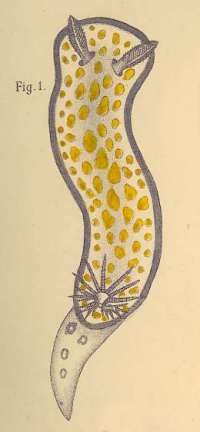
Here is another message concerning the white and purple-spotted chromodorids described from Hawaii by Pease and Garrett. In this one I post the original illustration of Doris prismatica var imperialis Pease, 1860. It was published unillustrated, a water colour by Garrett being published later by Bergh (1880: Pl. B, Figs 1-4) as Chromodoris imperialis. It is now known as Risbecia imperialis.
The original description included the following colour information:
"pale cream white, spotted above and on the sides with rich yellow: spots small irregular and slightly raised. The mantle is margined with purple and there are broken rings of the same colour on the sides and upper posterior end of the foot, each ring having a yellow centre". The gills are coloured "pale and edged with purple" and the rhinophore clubs are "deep black, minutely speckled with white and marked with two longitudinal white lines, one behind and the other in front"
-
Bergh, L.S.R. (1880) Malacologische Untersuchungen. In: C.G. Semper, Reisen im Archipel der Philippinen, Wissenschaftliche Resultate. Band 2, Suppl. 1, 1-78, Pls. A-F.
-
Pease, W. H. (1860) Descriptions of new species of Mollusca from the Sandwich Islands. Proceedings of the Zoological Society of London, 28, pp. 18-36.
Bill Rudman
Rudman, W.B., 2005 (Mar 7) Original illustration of Doris prismatica var imperialis Pease 1860. [Message in] Sea Slug Forum. Australian Museum, Sydney. Available from http://www.seaslugforum.net/find/13230Original illustration of Doris propinquata Pease 1860
March 7, 2005
From: Bill Rudman
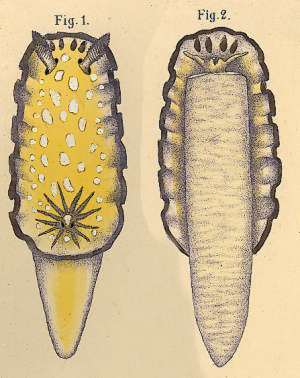
Here is another message concerning the white and purple-spotted chromodorids described from Hawaii by Pease and Garrett. In this one I post the original illustration of Doris propinquata, Pease, 1860
Doris propinquata was originally described (Pease, 1860) without an illustration. Bergh (1881: Pl. G, fig 1-2) subsequently published a painting by Andrew Garrett, which we assume was available to Pease. He called it Chromodoris propinquata.
Here is Pease's description of the external colour:
Colour above bright yellow, becoming white at the margins, which are bordered irregularly with purple; four oblong dots of the same colour in front of the dorsal tentacles. Dorsal tenatcles purple on the outer portion. Branchial plumes edged with the same colour. Length 1 inch 3 lines. This Doris possesses the same habit of vibrating its branchial plumes as Doris vibrata.
Kay & Young (1969) suggest this is probably C. vibrata, because they both vibrate their gills, but it could also be Risbecia imperialis which does the same. The large posterior foot is much more like a species of Risbecia than a Chromodoris.
-
Pease, W.H. (1860) Descriptions of new species of mollusca from the Sandwich Islands. Proceedings of the Zoological Society of London 28: 18-36.
-
Bergh, L.S.R. (1881) Malacologische Untersuchungen. In: C.G. Semper, Reisen im Archipel der Philippinen, Wissenschaftliche Resultate. Band 2, Supplement 2., 79-128, Pls.G, H, J-L.
Bill Rudman
Rudman, W.B., 2005 (Mar 7) Original illustration of Doris propinquata Pease 1860. [Message in] Sea Slug Forum. Australian Museum, Sydney. Available from http://www.seaslugforum.net/find/13253Trailing in Risbecia imperialis
August 17, 1999
From: Scott Johnson

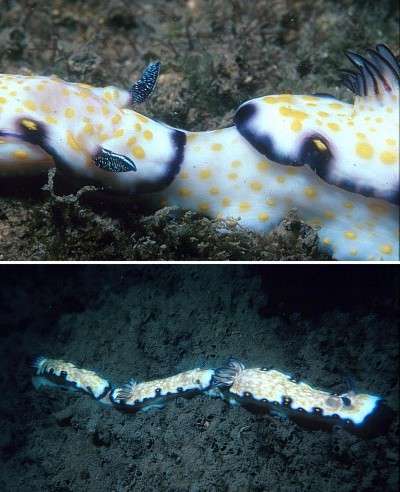
Hi Bill,
In the late 70s, when I was doing my opisthobranch work in Hawaii, one of my sites supported a good sized population of Risbecia imperialis. The site was along one side of a boat channel that led into Ala Wai Yacht Harbor in Honolulu. The area was pretty mucky and who knows what was in the water--the channel was the sole outflow to the sea from the Ala Wai Canal, into which drains runoff from rain that falls into several valleys above Honolulu. But it supported lots of various kinds of filter feeders, and several common species of nudibranchs. I could without much trouble count 50 or more R. imperialis on a single dive. I haven't been back for a while, but in recent years, John Hoover, author of the recently published Hawaii's Sea Creatures, has been diving the site. The R. imperialis are no longer there. Now the most common species is Tambja morosa, a species I never saw there in the late 70s.
One interesting feature of the Hawaiian Risbecia imperialis is that individuals can be identified by color pattern. The lateral margins have variable numbers of dark blue-black finger-shaped blotches extending towards the middorsum, and these blotches bear between 0 and about five orange spots. By recording the spots per blotch along each side, you could develop a code for a species and recognize them from one dive to the next. No doubt these spots would change over enough time, but it worked quite well in the short term. For several months, Hans Bertsch and I dove there regularly and recorded where and how we saw the individuals we recognized.
Individuals were nearly always paired, but sometimes in threes or even fours. They were either feeding on a blue-gray sponge I think is a species of Dysidea, or were actively moving. When moving, they always showed the trailing or queuing behavior. One interesting result we found was that the animals changed partners frequently. I watched it happen one day. Two pairs were moving along, each pair showing its own trailing behavior. While I was there, the two pair collided. After a confused moment, they rejoined in a queue of all four individuals. A few minutes later, the queue broke in half and the two pair went off in their own directions--having traded partners in the confusion. Apparently not very discriminating in their mates.
UPPER PHOTO: Three feeding on silt encrusted sponge.
MIDDLE: Close-up of a queue
LOWER: Three trailing across silt-covered bottom.
On a slightly different subject, do the specimens of this species (or of "godeffroyana") in the far western Pacific always match the coloration of those you have figured? Those I found in the Solomons were much like yours. I had always thought the coloration of the Hawaiian ones was unique until I found a single specimen of R. imperialis in the Marshalls; it looks just like a Hawaiian one.
Scott
johnson@kmr.ll.mit.edu
Johnson, S., 1999 (Aug 17) Trailing in Risbecia imperialis. [Message in] Sea Slug Forum. Australian Museum, Sydney. Available from http://www.seaslugforum.net/find/1196Dear Scott,
Thanks for these photos and the information. Looking at your Hawaiian animals again, I must say I wonder if we are premature in considering R. godeffroyana and R. imperialis to be synonyms. Certainly most of the western Pacific animals I have seen alive, or in photos, match the photos at the Top of the Page, but there are some which don't have the pinkish central region and have only large yellow spots, somewhat like the Hawaiian (and Marshall Ids) colour pattern. But looking again at your photos, I wonder if they are the same. I'll try and find a good photo to post. If anyone has evidence of either colour form outside their 'normal' geographic ranges we would love to hear of it.
Bill Rudman.
